Pedro Rodriguez is professor of plant biochemistry at the Instituto De Biología Molecular Y Celular De Plantas (IBMCP) in Valencia, Spain, where he works since 1998. Aneurus Inconstans is an anonymous image integrity expert who specialises in plant sciences. The two had a lively debate on PubPeer, others joined and now 15 of Rodriguez papers are flagged for image duplications. And then I had an even livelier email exchange with Rodriguez, which somehow included him requesting a retraction of one of his problematic papers, and then calling me a “Spanish Inquisition”.
The journals affected in this affair are all issued by learned societies, namely the American Society of Plant Biologist (ASPB) and the Society for Experimental Biology (SEB), and count as the most respectable in the field of plant sciences. These journals also have generally a good record of cracking down on data manipulation. Even if plant sciences are not free of fraud (see for example Olivier Voinnet affair), the field is much less fraud-tolerant, fake plant science gets retracted.
One of the journals discussed here, The Plant Cell, even dismissed their just-appointed Editor-in-Chief, Sally Assmann, because of research malpractice in her lab:
Unlike in biomedicine, where even the most notorious research fraudsters constantly get rewarded to drive home a point, and even nobodies with their fake papermill products are safe from retractions most of the times. This is why I prefer writing about plant sciences rather than about toxic dumps called cancer, ageing or regenerative medicine research. But of course it’s not black-and-white, there are very honest biomedical journals like Journal of Biological Chemistry or (since recently) PLOS One, and very disappointing exceptions among plant science journals, the commercial ones for sure, but also the society-run Journal of Experimental Botany here.
“We want to make a retraction”
So, without any further ado, here is the paper Rodriguez decided to retract:
Julia Santiago, Americo Rodrigues, Angela Saez, Silvia Rubio, Regina Antoni, Florine Dupeux, Sang-Youl Park, José Antonio Márquez, Sean R. Cutler, Pedro L. Rodriguez Modulation of drought resistance by the abscisic acid receptor PYL5 through inhibition of clade A PP2Cs The Plant journal (2009) doi: 10.1111/j.1365-313x.2009.03981.x

Elisabeth Bik joined Aneurus Inconstans in the treasure hunt, and found more:
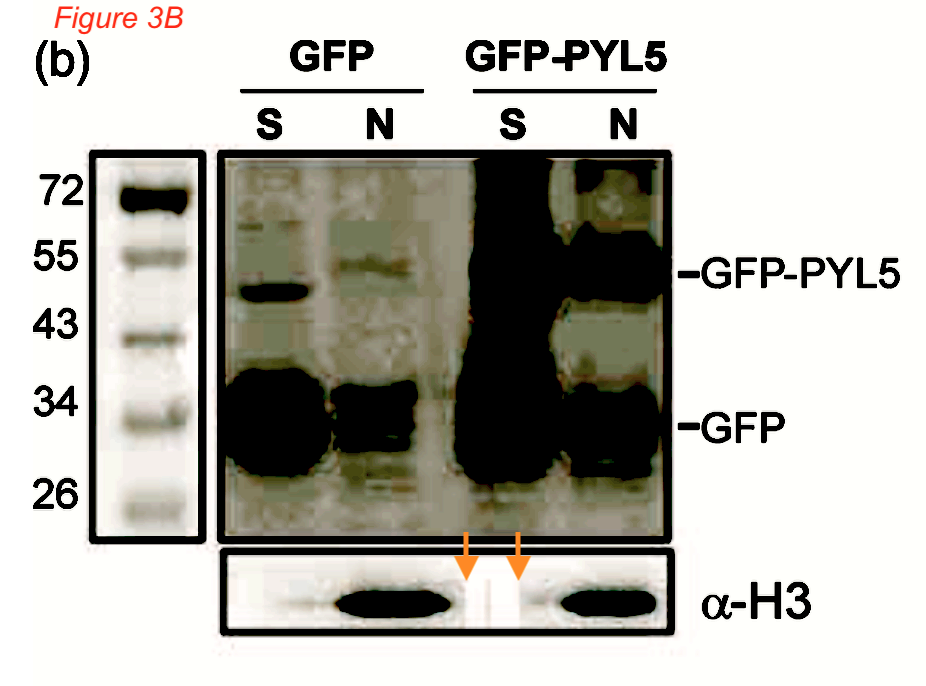

Penultimate author Sean Cutler, professor at University of California Riverside commented:
“Thank you for drawing attention to these issues. The figures/data in question did not originate from my laboratory at UC-Riverside and I do not have copies of underlying raw data used for the figure preparation nor do I have a simple explanation for the irregularities noted. I have contacted the corresponding author of the manuscript and he has indicated that he will respond.“
On 24 June 2021, Rodriguez informed the journal (with me in cc):
Dear Editor,
We want to make a retraction corresponding to the article:
Santiago, J., Rodrigues, A., Saez, A., Rubio, S., Antoni, R., Park, S-Y., Dupeux, F., Marquez, J.A., Cutler, S.R. and Rodriguez, P.L. (2009). Modulation of drought resistance by the abscisic acid-receptor PYL5 through inhibition of clade A PP2Cs. Plant J 60, 575-588.
Recently we realized that some images were used wrongly in the paper, so I want to retract this article.
The key message of the paper is very solid and results have been reproduced independently in many laboratories, but I find unacceptable the wrong use of some images during figure preparation
Please, let me know the procedure
Pedro Rodriguez
The first author of that disastrous publication, Julia Santiago, is currently tenure-track professor in Switzerland, her chair is financed by the Sandoz Family Foundation. The Santiago lab is also funded since 2017 by a €1.5 million ERC Starting Grant. I informed the ERC and Santiago’s new employer, University of Lausanne. ERC replied:
“The ERC will examine this information and address it within its applicable legal and procedural framework.“
The Naughty Pin Replicator
The University of Lausanne didn’t reply, and neither did Professor Santiago. At least her former postdoc advisor at the nearby University of Geneva, Michael Hothorn, shared his views on Twitter:
Here are more papers of Dr Santiago with Prof Rodriguez. Like this one:
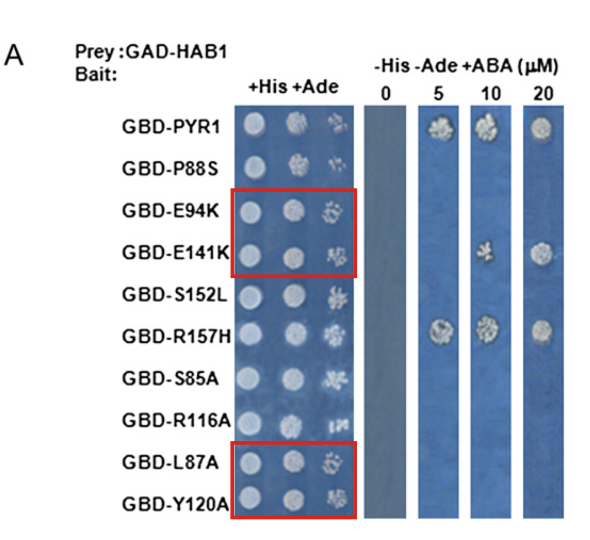
Florine Dupeux, Regina Antoni, Katja Betz, Julia Santiago, Miguel Gonzalez-Guzman, Lesia Rodriguez, Silvia Rubio, Sang-Youl Park, Sean R. Cutler, Pedro L. Rodriguez, José A. Márquez Modulation of Abscisic Acid Signaling in Vivo by an Engineered Receptor-Insensitive Protein Phosphatase Type 2C Allele PLANT PHYSIOLOGY (2011) doi: 10.1104/pp.110.170894
“Figure 3A, two sets of yeast colonies appear to be duplicated (red boxes).“
The last author José Márquez, who did a PhD in Valencia and is now team leader at EMBL in Grenoble, France, commented on PubPeer:
“The experiments in question were carried out in the laboratory of the corresponding author, Pedro Luis Rodriguez. I recently became aware of several other claims concerning the same group. I’ll be contacting him for information. “
Or this paper from the Rodriguez lab, Elisabeth Bik even included it in her popular Twitter “Spot the Problem” contest:
Silvia Rubio, Americo Rodrigues, Angela Saez, Marie B. Dizon, Alexander Galle , Tae-Houn Kim , Julia Santiago , Jaume Flexas , Julian I. Schroeder , Pedro L. Rodriguez Triple Loss of Function of Protein Phosphatases Type 2C Leads to Partial Constitutive Response to Endogenous Abscisic Acid PLANT PHYSIOLOGY (2009) doi: 10.1104/pp.109.137174
This is what Bik’s followers found, a flipped segment with digitally cloned baby plants:

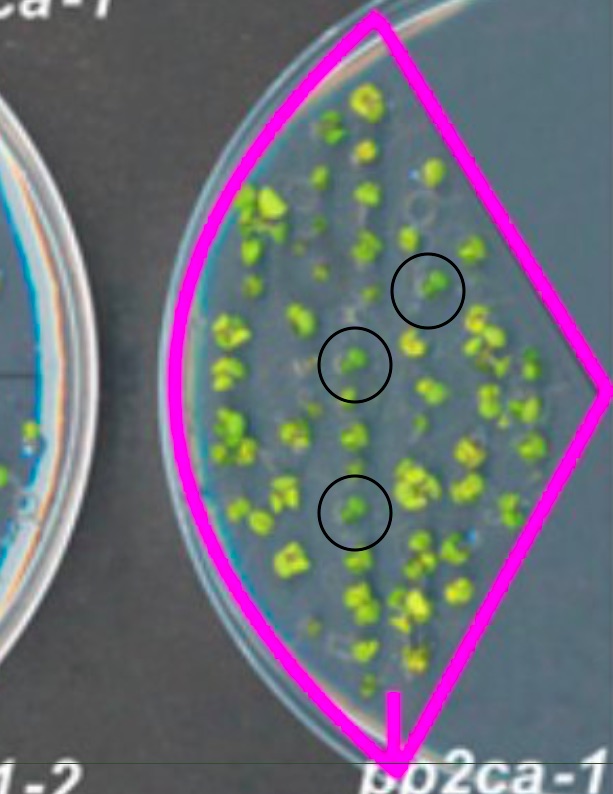
So much to analyse in that little dish:
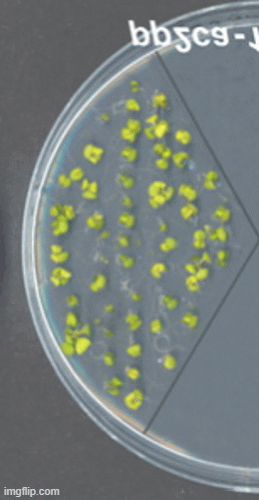
Orchestes Quercus made an overlay on PubPeer: “It is a curious beast. The arrangement is mirrored vertically and shifted with respect to the edge of the dish. The plant in the blue box in #1 seems to have jumped. Others have grown or withered, whilst the majority stays completely unchanged.“
Or, also very bad, this paper with many recurrent author names:
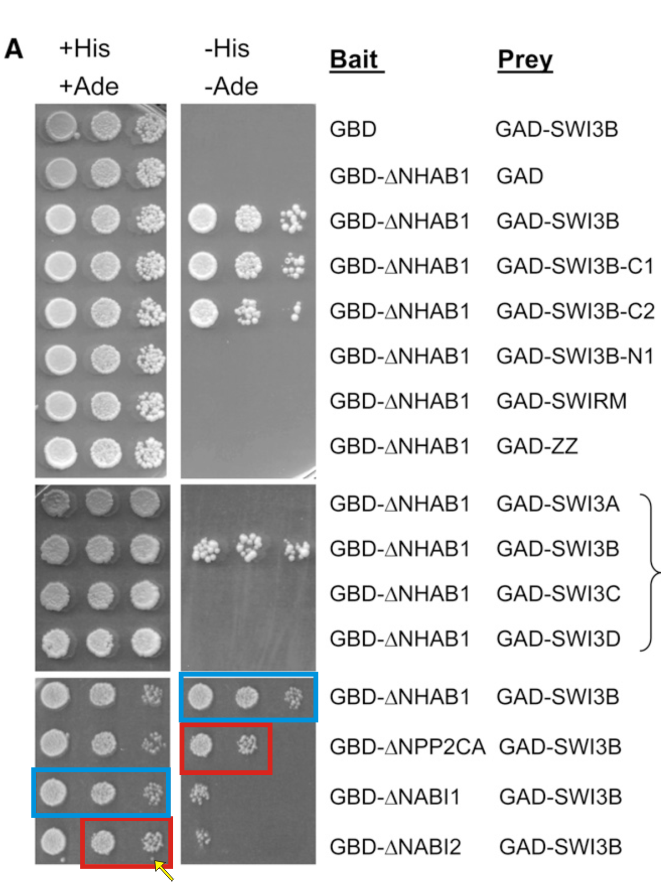
Angela Saez , Americo Rodrigues, Julia Santiago, Silvia Rubio, Pedro L. Rodriguez HAB1–SWI3B Interaction Reveals a Link between Abscisic Acid Signaling and Putative SWI/SNF Chromatin-Remodeling Complexes in Arabidopsis The Plant Cell (2008) doi: 10.1105/tpc.107.056705
“Figure 1A, two sets of yeast colonies appear to be duplicated (red and blue boxes). Please note that the yellow arrow points to a scattered colony that has been blurred in right column, presumably to better hide the duplication?“
Rodriguez commented:
“We are currently checking our pin replicator. It will take two weeks to check whether pins can generate such problem It is quite difficult to localize authors responsible of figure preparation after 13 years Indeed, one author of this paper passed away last year“
But then Cheshire aka Actinopolyspora Biskrensis chimed in:

“After enhancing the contrast and brightness, one can easily discern the background repetitions (see green and cyan boxes as examples). Unfortunately, the author’s suggestion that mistakes can happen does not address the concern that the images appear to have been edited – I can think of no other explanation for the clear differences within the yellow and magenta circles.”
Elisabeth Bik found something as well, in Figure 4H: “Some of the baby plant parts appear to look more similar than expected.“
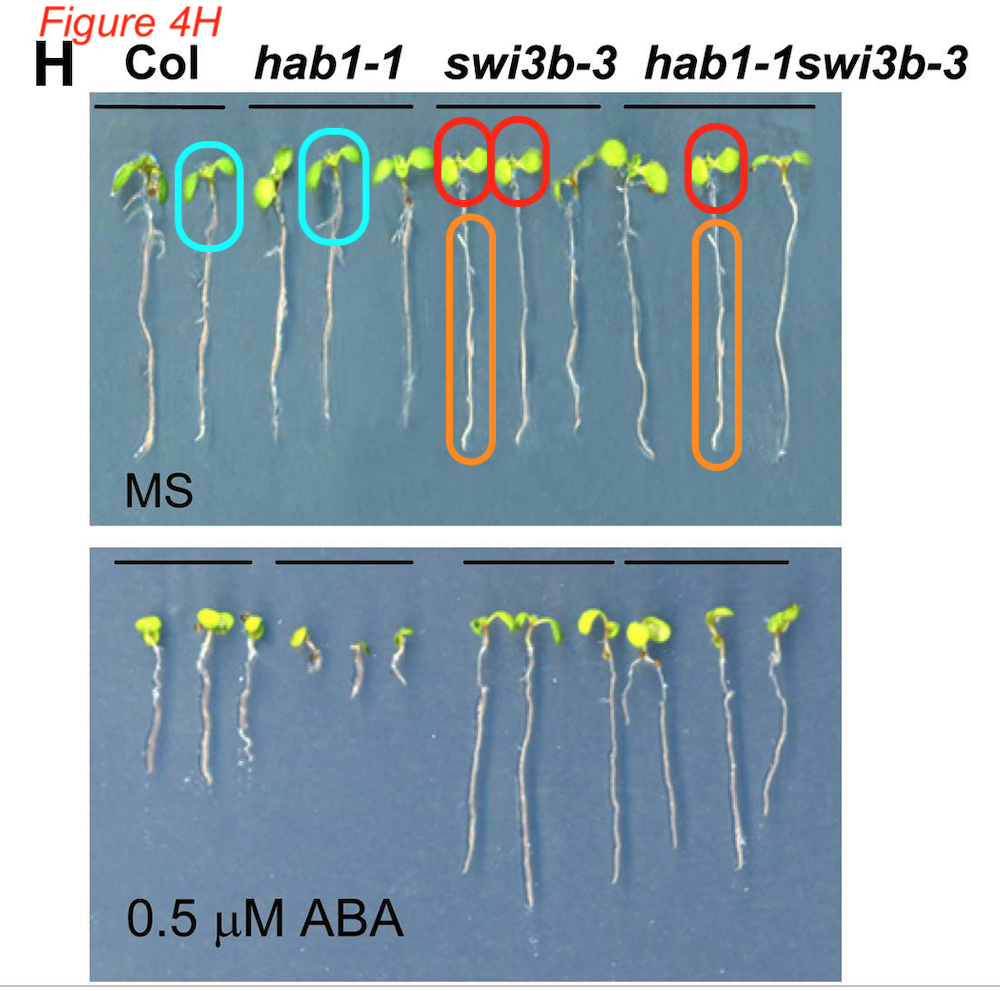
Rodriguez then pleaded:
“Please, we need some time to check the issue about the replicator. Finally, if these data are misrepresented, we will repeat the experiments and send the corresponding post Unfortunately, we do not have the original images after 13 y, and I do not have access to forensic tools as you are using here…”
There is of course more, even without Santiago. The following paper also fell prey to a malicious pin replicator.
Lesia Rodriguez , Miguel Gonzalez-Guzman, Maira Diaz, Americo Rodrigues, Ana C. Izquierdo-Garcia, Marta Peirats-Llobet, Maria A. Fernandez, Regina Antoni, Daniel Fernandez, Jose A. Marquez, Jose M. Mulet, Armando Albert, Pedro L. Rodriguez C2-domain abscisic acid-related proteins mediate the interaction of PYR/PYL/RCAR abscisic acid receptors with the plasma membrane and regulate abscisic acid sensitivity in Arabidopsis The Plant Cell (2014) doi: 10.1105/tpc.114.129973
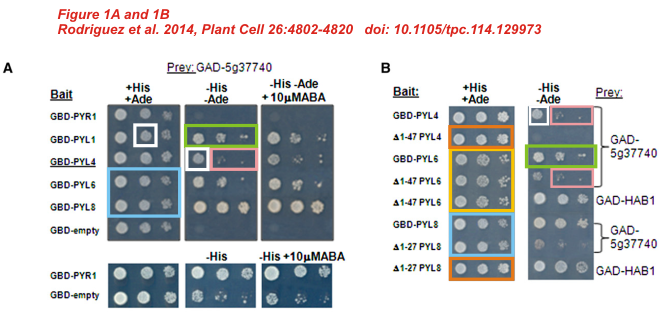


Pedro Rodriguez, for some reason commenting as the first author Lesia Rodriguez Solovey (no relation), explained:
“I am not satisfied with the whole figure and we are going to repeat the experiments. Unfortunately, one key author of this paper passed away last year […reference to the late Portuguese professor Américo Rodrigues, -LS…], so we are missing key information. Yeast two hybrid assays of this paper were done several years before, probably by the same person who was involved in Santiago et al., 2009. I am not aware that journals request raw data for 10 y (even tax declaration only requires 5 y). We are not immune to informatic problems. One of the authors involved in the preparation of the figures will explain it. However, we maintain glycerol stocks (even more than 10 years!) and we can repeat the experiments.“
I’m not sure what the point of repeating the experiment is, when such “informatic” problems are found. Are Rodriguez’ students allowed to sit the exact same written exam again after they were caught cheating in it? I guess not? So why is this Dr Informatic allowed to do that?
In this collaborative paper, Rodriguez’ Chinese colleagues admitted a mistake in Figure 2A:

Qian Wu , Xu Zhang , Marta Peirats-Llobet , Borja Belda-Palazon, Xiaofeng Wang , Shao Cui , Xiangchun Yu , Pedro L. Rodriguez, Chengcai An Ubiquitin Ligases RGLG1 and RGLG5 Regulate Abscisic Acid Signaling by Controlling the Turnover of Phosphatase PP2CA The Plant Cell (2016) doi: 10.1105/tpc.16.00364
Qian Wu and Xu Zhang: “we’re terribly sorry to say it was indeed a mistake generated when Qian was assembling the yeast strips into the figure showed in the paper.“
But whose mistake was the following (found by Cheshire), also Qian’s? Fig 4D shows not just duplicate images, they were also darkened, shifted or (yellow boxes) rotated. Honest mistake, really?

Indeed, Rodriguez hints on PubPeer that the Chinese colleagues are responsible:
“The figures/data in question did not originate from my laboratory“
But:
“I can understand that minor mistakes occur during the preparation of the figure, which do not affect the conclusions of the work.“
How can he be so sure then?
Honest mistakes
Can a pin replicator replicate pictures of plants and western blot bands? An academic question also for this collaborative study with Rodriguez colleague at National Center for Biotechnology in Madrid, Vicente Rubio:
María Luisa Irigoyen, Elisa Iniesto, Lesia Rodriguez, María Isabel Puga, Yuki Yanagawa, Elah Pick, Elizabeth Strickland, Javier Paz-Ares, Ning Wei, Geert De Jaeger, Pedro L. Rodriguez, Xing Wang Deng, Vicente Rubio Targeted degradation of abscisic acid receptors is mediated by the ubiquitin ligase substrate adaptor DDA1 in Arabidopsis The Plant Cell (2014) doi: 10.1105/tpc.113.122234

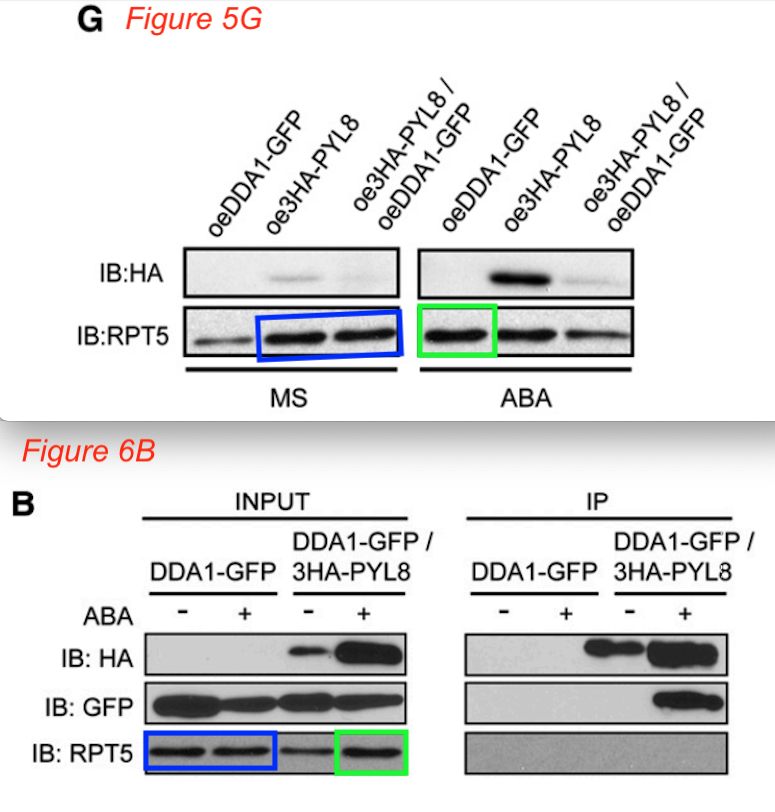
Rodriguez commented in this regard:
“The figures/data in question did not originate from my laboratory and I do not have copies of underlying raw data used for the figure preparation“
More image reuse, this time likely in Rodriguez’ own lab, also spotted by Bik:
Miguel Gonzalez-Guzman, Gaston A. Pizzio, Regina Antoni, Francisco Vera-Sirera, Ebe Merilo, George W. Bassel, Maria A. Fernández, Michael J. Holdsworth, Miguel Angel Perez-Amador, Hannes Kollist, Pedro L. Rodriguez Arabidopsis PYR/PYL/RCAR receptors play a major role in quantitative regulation of stomatal aperture and transcriptional response to abscisic acid The Plant Cell (2012) doi: 10.1105/tpc.112.098574
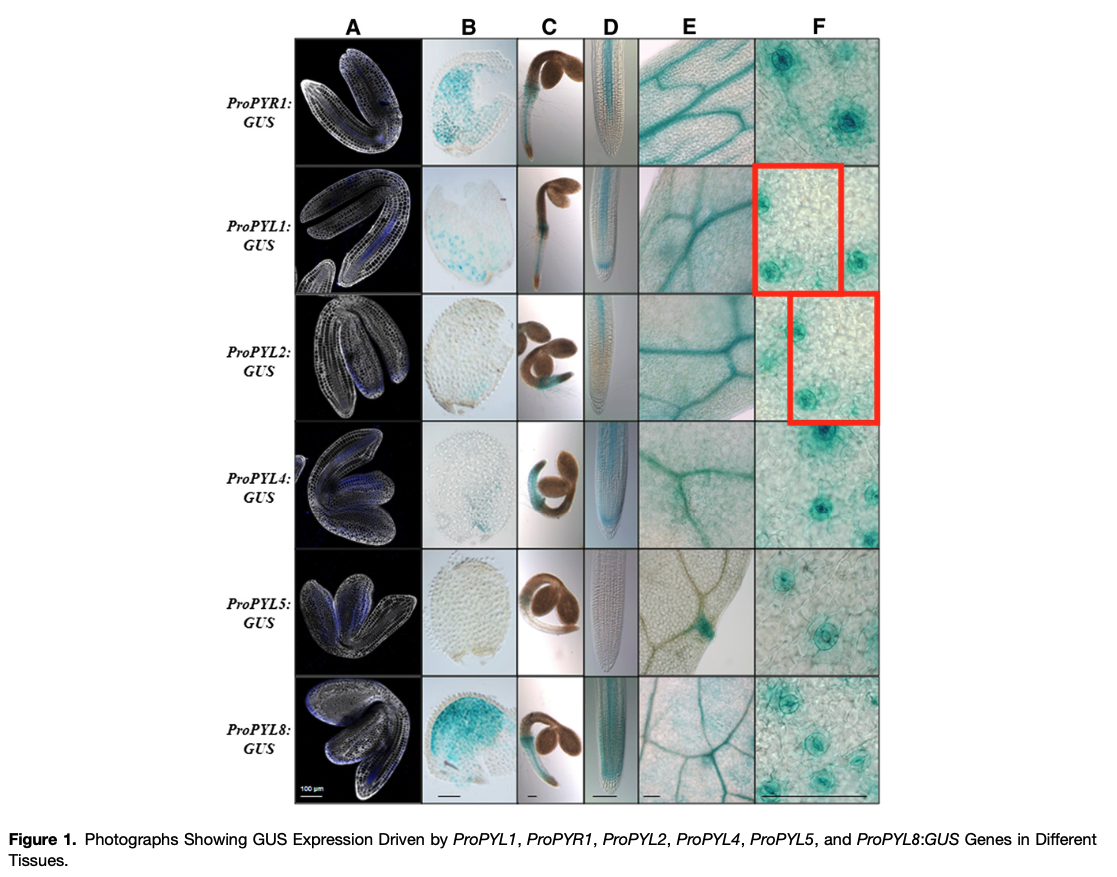

Regarding the pentuplicated RT-PCR gel experiment in Fig 3A, Rodriguez stated on PubPeer:
“I really do not know if the background should be different, particularly in the darker version you show.”
Can someone show the professor how DNA gels work?
Anyway, this all must have been an “honest mistake”, given how Rodriguez describes for the next paper the missteps of his PhD student Miguel Gonzalez-Guzman, who is now investigator at the University Jaume I, also in Valencia:
Miguel González-Guzmán, David Abia , Julio Salinas , Ramón Serrano, Pedro L. Rodríguez Two new alleles of the abscisic aldehyde oxidase 3 gene reveal its role in abscisic acid biosynthesis in seeds PLANT PHYSIOLOGY (2004) doi: 10.1104/pp.103.036590
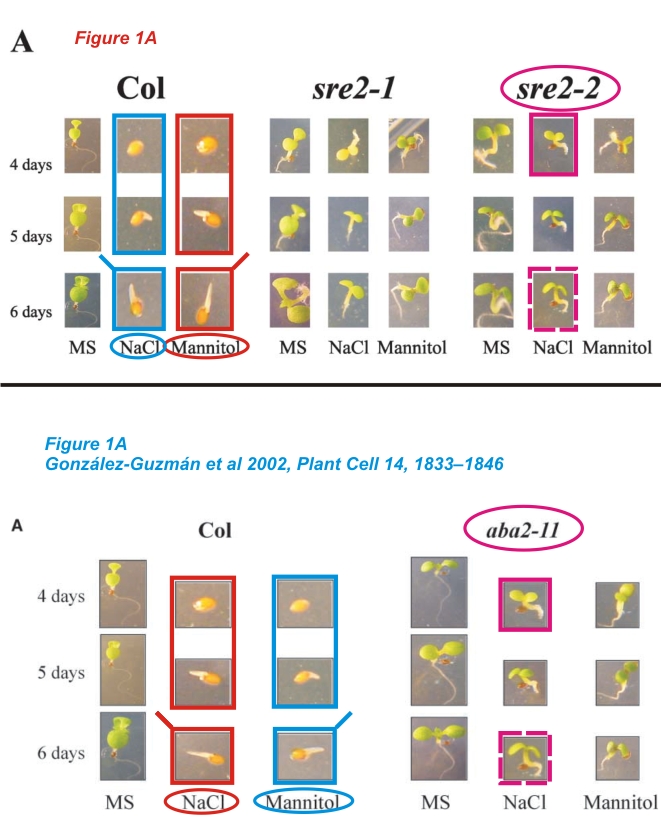
Rodriguez shared with me a reply to “Dear Aneurus Inconstans” which Gonzalez-Guzman planned to post on PubPeer (here it is now). It is indeed tricky to explain. The “MS” images for Col on the left-hand side are identical also, but the NACl and Mannitol samples got swapped between papers. It seems the authors split one experiment into two publications, which is OK in itself, but not OK is that they apparently only ever took one close-up picture for each plant genotype, experimental condition and time point, and called it representative. As Rodriguez informed me, “aba2-11 is another name for sre1“, so the image re-use for another salt-resistant mutant, sre2-2, was not appropriate.
The penultimate author Ramon Serrano is Rodriguez’ former mentor and now emeritus professor at the same IBMCP in Valencia. He and Gonzalez-Guzman are also on this paper:
Silvia Rubio, Tony R. Larson, Miguel Gonzalez-Guzman, Santiago Alejandro, Ian A. Graham, Ramón Serrano, Pedro L. Rodriguez An Arabidopsis mutant impaired in coenzyme A biosynthesis is sugar dependent for seedling establishment PLANT PHYSIOLOGY (2006) doi: 10.1104/pp.105.072066

Further analysis by A, Inconstans showed that the gel bands seem indeed duplicated. Rodriguez commented on PubPeer:
“After receiving your comments, I have realized that a checking point of figures with forensic tools is required. I would say this should be performed by journals before final acceptance, indeed that is the case for some of them.“
I’m not sure the journal editors will agree that the blame lies on them. Sure, journals should be checking papers for data manipulations, but AFAIK it is authors’ own responsibility not to fake data in the first place.
Rodriguez replied the same way on another PubPeer thread. This was the oldest paper flagged so far:

Rosario Gil-Mascarell, Jose M. Lopez-Coronado, Jose M. Belles, Ramon Serrano, Pedro L. Rodriguez The Arabidopsis HAL2-like gene family includes a novel sodium-sensitive phosphatase The Plant journal (1999) doi: 10.1046/j.1365-313x.1999.00385.x
“Figure 3b, it looks very much like as three out of five lanes are the same, although contrast is a bit different (red boxes).“
The gradient map even reveals splice edges, suggesting the gel image is a digital composite.
Rodriguez commented on PubPeer:
“I can understand that DNA bands look very similar in the black/white negative, but I do not have forensic tools as you have. Anyway, this figure is redundant with panel B. You are raising an important question in scientific publications.“
Followed again by the disappointment that the journal editors didn’t catch that.
Kudla in Münster
Aneurus Inconstans stumbled across Rodriguez’ papers while analysing the works of someone else, namely of Jörg Kudla, professor at University of Münster in Germany, who now has 9 papers flagged on PubPeer. Here is that collaborative paper between Rodriguez and Kudla:
Borja Belda‐Palazon, Jose Julian, Alberto Coego, Qian Wu, Xu Zhang, Oliver Batistic, Saleh A. Alquraishi, Joerg Kudla, Chengcai An, Pedro L. Rodriguez ABA inhibits myristoylation and induces shuttling of the RGLG 1 E3 ligase to promote nuclear degradation of PP 2 CA The Plant journal (2019) doi: 10.1111/tpj.14274
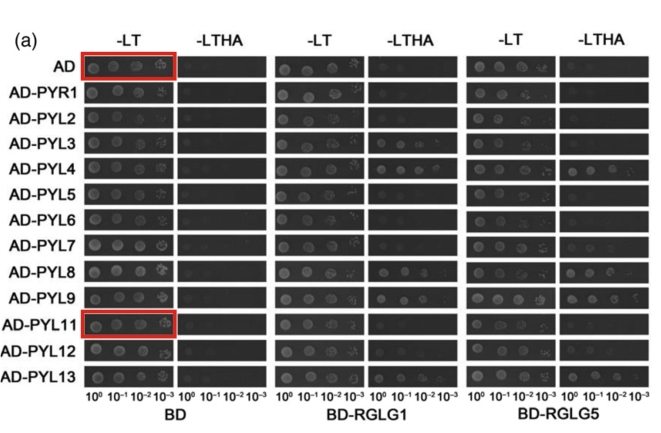
An anonymous commenter, who later turned out to be Rodriguez, wrote:
“The last yeast dilution (10-3) contains a low number of cells, which are applied using Boekel Scientific™ 48/96 Pin Replicators (not by hand), so there is a chance that some pins produce a similar pattern“
A. inconstans retorted:

“Thank you for pointing this out, BUT in this case it seems they are indeed same set of colonies:
Resolution is slightly different between two images, however it is quite clear they are the same.“
Rodriguez was only partially swayed:
“Ok, thanks, then it might be a mistake (1 out of 72 panels) in the preparation of the figure Alternatively, some pins might produce a similar imprint because they are burned with ethanol to eliminate the yeast colonies.“
That naughty pin replicator again. And you know what? It even travelled to Münster to attack Kudla’s own research!
Üner Kolukisaoglu, Stefan Weinl, Dragica Blazevic, Oliver Batistic, Jörg Kudla Calcium sensors and their interacting protein kinases: genomics of the Arabidopsis and rice CBL-CIPK signaling networks PLANT PHYSIOLOGY (2004) doi: 10.1104/pp.103.033068

Also Kudla admitted the duplications, but:
“The marked panels of yeast colonies are identical. This mistake does not affect the conclusion of this experiment […] Moreover, several of the reported CBL1 and/or CBL9-CIPK interactions have been independently confirmed in a number of subsequent publications“
I informed the publisher and the University of Münster. The former promised an investigation, the Ombudsman of the latter informed me:
“Prof. Kudla has informed me that the scientific integrity and conclusions of the publications you mentioned are in no way objectionable, but that there have been errors – especially in the representations – which require clarification and correction. The correction process was initiated long before your complaints were received [this paper and most others were first flagged by A. inconstans on PubPeer 21-26 May 2021. I informed the university on 27 May, -LS]. The correspondence with the magazines in which the corrections are to be printed has been forwarded to me. In essence, the correction process has already been completed. Some corrections have also already been made to PubPeer. Only one publication is still open in the journal Plant Physiology.[…]
In view of this situation, I see no reason to forward the matter to the investigative commission of our university for the procedure in the event of suspected scientific misconduct.“
Kudla never replied to my emails. I understand, I am not popular with Münster professors, after the Püschel and Schwamborn affair.
“I am not under investigation“
But I exchanged many emails with Rodriguez. Here some excerpts:
“PIs usually trust in the work of students, who are excellent persons but sometimes make mistakes (as we do because even scientists are human beings). Most of the problems detected by Pubpeer (in my case) are the loading controls of drop tests. I have original files for some of these experiments and I do not understand why the students have chosen wrong yeast strips. I could speculate, but this is not helpful
Anyway, I am aware I face a difficult time and I will contact editors to explain the problems detected by Pubpeer. In the meantime we are repeating some of these assays and we are checking the original files when possible […]
Perhaps I trusted too much in figure preparation (this is a duty for PhD training), which I have improved during my last years.
Usually the pubpeer analyses are focused on relatively old articles, so it is difficult the correction of mistakes Two minor questions raised on recent articles have been corrected and in one case the correction was posted (https://doi.org/10.1105/tpc.20.00781). So, we need time to check the other problems […]
I am not under investigation. I will contact the editors of the journals and I will explain the problems detected.
Then, we will see what happens. I can take full responsibility if results obtained in my lab are not reproducible or if our genetic resources are not available for other people, for example. But fortunately, this never happened in my career, indeed we have provided a rich source of materials that were very useful to other scientists“.
The Plant Journal informed that they are processing Rodriguez’ retraction request. A good start. In his last email to me, Rodriguez wrote:
“If you do not accept honest mistakes, you destroy science. Your blind fury against wrong images does not consider the whole message and prevents a reasonable explanation
Come on, you want a better science, but this looks like the Spanish Inquisition“
Nobody expects the Spanish Inquisition.
This article was slightly updated soon after it first appeared, e.g. due to new PubPeer comments by Rodriguez.

Get For Better Science delivered to your inbox.
Make a one-time donation
Make a monthly donation
Choose an amount
Or enter a custom amount
Your generous patronage of my journalism will be most appreciated!
Your generous patronage of my journalism will be most appreciated!
DonateDonate monthly

Dr. Rodriguez: The emotional desire to trust one’s mentees and colleagues is understandable and even admirable. However, science is based on facts, not emotions. ‘Trust but verify,’ is how science works.
The data represented by the images in a research paper are one part of the facts supporting the conclusions. While they are not the entirety of the facts, they are one of the few bits of verifiable evidence that outside observers can use to confirm that the investigation supports the conclusions of a paper, short of replicating to experiments. They are not merely illustrations and concerns about image manipulation should not be dismissed.
In my opinion, once image manipulation is suspected, one should flip the ‘trust but verify’ approach to ‘verify, then trust.’ Readers now need to consider the possibility that other data may also have been manipulated. As this is difficult for outsiders to determine, a complete investigation into these papers is definitely warranted.
There is already a shadow cast over the papers, authors, and institutions involved here. A thorough and independent examination of the facts is the best way to alleviate these suspicions.
LikeLike
Forwarded to me by a friend:
Dear Prof. Cuesta-Valera, dear Prof. Picó-Sirvent,
[…] I wish to bring to your attention that serious concerns have recently arisen in PubPeer
regarding several articles from the group of Prof. Pedro L. Rodriguez
at The Institute for Plant Molecular and Cellular Biology (IBMCP).
Prof. Rodriguez has 13 articles flagged on PubPeer.
https://pubpeer.com/search?q=pedro+l+rodriguez
[…] I believe that you both, as Vice Rector for Art, Science, Technology and Society and for Research, respectively, may wish to consider investigating these cases of potential scientific misconduct, in case you find these concerns compelling.
Thank you for your attention.
Dear XXX,
The matter you state in your message will be treated at the next meeting of the UPV ethics committee.
I would be grateful if you would state your interest in the matter and send me all the additional information that you consider relevant so that this issue may be dealt with, in depth, by the members of the committee.
Thank you for bringing this to our attention,
YYY
Ethics Committee Secretary
Dear XXX,
I am writing to you again, to inform you that we have also forwarded your message to the CSIC ethics committee (https://www.csic.es/en/csic/scientific-integrity-and-ethics-csic/csic-ethics-committee), as Prof. Rodriguez is employed in CSIC.
I will keep you informed about the outcome of the meeting.
Thank-you,
YYY
Ethics Committee Secretary
Dear Ms YYY,
thank you for your email. I’m one of the anonymous people that reported some of these articles in PubPeer. […]
Additional information on this case can be found in the journalistic article of Leonid Schneider, who covered well the whole matter, here:
https://forbetterscience.com/2021/06/28/nobody-expects-the-spanish-inquisition/
Kind regards,
LikeLike
You may want to let your friend know about the fabricated figures/chapter of these two Phd Theses
https://pubpeer.com/publications/0E1F7AC125E93D983A952B1D342F20
The Polytechnic University of Valencia (UPV) does have clear guidelines to deal with research integrity issues associated with PhD students and researchers from UPV.
LikeLike
Dr Yasin Degdas is apparently not a fan of our work:
I’m sure he doesn’t approve of Dr Bik either, but is afraid to say so.
Why, it’s complicated. I previously wrote about Degdas’ Gregor Mendel Institute (GMI) in Vienna and its researchers Arturo Mari-Ordonez (former PhD student of Olivier Voinnet) and Ortrun Mittelsten-Scheid (GMI Professor)
Now, Mittlesten Scheid lab hosts the former PhD student of Voinnet’s right-hand man Patrice Dunoyer, Marco Incarbone. Whose lady friend Marion Clavel is in Dagdas group, and she is a former PhD student of Pascal Genschik:
Science is a village.
LikeLike
Your wife might find you pretty hot in a red cape, Schneider. You already have the accusatory tone, but with a much smoother delivery.
This is pretty shocking. And Ms. Santiago gets a faculty position from this crap? She might as will go to Weill-Cornell. Same with Yasin Dagdas.
LikeLiked by 1 person
Fetch the Comfy Chair!
LikeLike
https://www.pubpeer.com/publications/9A2DBFED17A4CD31A4876CC39E95B8
https://www.pubpeer.com/publications/5382D9ED07E803492B4D5D63A5604F
LikeLike
“ I am Julia Santiago the seventh author of this publication. As of today, there are 14 publications (1999-2019) from the laboratory of my former PhD supervisor Dr. Rodriguez flagged for image irregularities or potential manipulations on Pubpeer, four of which list my name as co-author. I did my PhD in the laboratory of Dr. Pedro Rodríguez at the IBMCP in Valencia, Spain from 2007 to 2011. I have performed part of my thesis research at the EMBL in Grenoble, France, from 2009 to 2011, under the supervision of Dr. Jose Antonio Marquez.
Rubio et al., Plant Physiol, 2009, DOI: 10.1104/pp.109.137174 contains figure panel 4C flagged for image irregularities/manipulation. To this study I contributed raw data to the leaf fresh weight drought assays shown in Fig. 1C,D and to the microarray analysis shown in Fig. 6A. I did not assemble any of the final figures used for this publication.
Although I have not done any of the flagged image manipulations, I regret that I did not spot these irregularities myself.”
From:
https://pubpeer.com/publications/84C07033011466396B06A41507C8F9#3
LikeLike
Julia Santiago declares regarding her paper slotted for retraction:
https://pubpeer.com/publications/441218C84F4A8F21AF7932C06CAFC5#7
“I contributed to Santiago et al., Plant Journal, 2009: DOI: 10.1111/j.1365-313X.2009.03981.x part of the yeast-two-hybrid (Y2H) experiments now being flagged for image manipulation (Fig. 1). I was not involved in the selection of the figure panels or in the assembly of the final figure for publication. I checked my notes and my contribution to this work further includes the experiments shown in Fig. 3d,e; Fig. 4a,b; Fig. 5; Fig. 6 and the analyses and panels of the ITC binding assays shown in Fig. 7. I did not contribute to the experiments shown in Figures 3b and Figures 4d. I was not involved in the final figure assembly prior to publication. I have left my lab notebooks and all original data generated during my PhD in the host laboratory.
Although I have not done any of the flagged image manipulations, I regret that I did not spot these irregularities myself. I fully support retraction of this article and I will do my best to contribute to the clarification of these issues.”
Similar note was placed on other paper Santiago coauthored.
LikeLike
I have found interesting the several posts by A/Prof Julia Santiago shifting the blame. Mainly, because most of the figures flagged as presumably manipulated are part of the results of her PhD Thesis, which was written in English and it is publicly available through this link (https://riunet.upv.es/bitstream/handle/10251/13260/tesisUPV3647.pdf?sequence=1&isAllowed=y).
In the light of comments made here and in PubPeer, I believe it would be of interest posting some presumably misleading images from Chapter 4 of Julia Santiago’s PhD Thesis. Unfortunately, I cannot upload figures here, but in any case, the problematic images can be easily spotted following these notes:
1- Chapter 4. Page 155, Figure 5 upper row. First image from the left. Apparently duplicated and horizontally flipped plant (first and third) to show two different genotypes, with potential manipulation (a piece of root in first plant is not present in the third plant)
2-Chapter 4. Page 155, Figure 5 lower row. First image from the left. Apparently duplicated and horizontally flipped plant (first and third) to show two different genotypes, with potential manipulation (a leave in first plant is not present in the third plant)
3- Chapter 4. Page 157. Figure 6A.
3a- Left image. Apparently duplicated and horizontally flipped plant (first and third) to show two different genotypes.
3b- Middle image. Apparently duplicated and horizontally flipped plant (second and third) to show two different genotypes.
3c- Right image. Apparently duplicated plants (first and third).
4-Chapter 4. Page 159. Figure 7B. Apparently duplicated loading control; Lanes 3-6 in the blot of the left are extremely similar to lanes 1-4 in the blot of the right.
LikeLike
Oh. Who manipulated these images in Dr Santiago’s PHD thesis then?


Universidad Politécnica de Valencia
Structural insights into ABA perception and signalling: structure of ABA receptor PYR1
Dissertation for the degree of Doctor (PhD) in Biotechnology
By Julia Santiago Cuéllar
Supervisor Pedro L. Rodríguez Egea
Click to access tesisUPV3647.pdf
More:
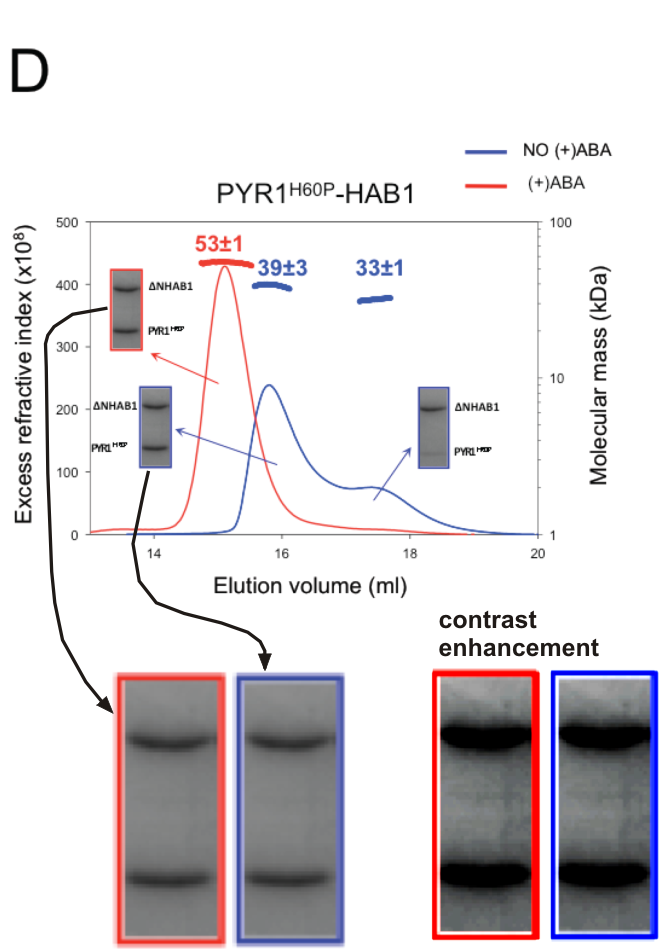
“Chapter 3, Figure 3D, of the PhD Thesis by the first author of this publication Dr. Julia Santiago (red and blue colors are from original figure):”
Published in
Florine Dupeux, Julia Santiago, Katja Betz , Jamie Twycross , Sang-Youl Park , Lesia Rodriguez , Miguel Gonzalez-Guzman, Malene Ringkjøbing Jensen , Natalio Krasnogor , Martin Blackledge , Michael Holdsworth , Sean R Cutler, Pedro L Rodriguez, José Antonio Márquez
A thermodynamic switch modulates abscisic acid receptor sensitivity
The EMBO Journal (2011) doi: 10.1038/emboj.2011.294
https://pubpeer.com/publications/338F3AAAECAD47C60CFC37C101DDC1#2
LikeLike
Oh dear. Another PhD student of Pedro Rodriguez, Regina Antoni Alandes, currently Head of Single Cell Unit at Josep Carreras Institute.
She defended her PhD 2 years after Julia Santiago. here is the thesis: https://riunet.upv.es/bitstream/handle/10251/29756/tesis final impresa.pdf
Yet Alandes reused some data from Santiago’s thesis, here with some additional experiments:


Under certain circumstances, this might be permissible but WITH acknowledgement. The Regina Alantes thesis instead passes off that work as her own. In another case, the entire figure was copy-pasted 1:1
This figure appeared in this paper:
Florine Dupeux , Regina Antoni , Katja Betz , Julia Santiago, Miguel Gonzalez-Guzman, Lesia Rodriguez , Silvia Rubio , Sang-Youl Park , Sean R. Cutler, Pedro L. Rodriguez, José A. Márquez
Modulation of Abscisic Acid Signaling in Vivo by an Engineered Receptor-Insensitive Protein Phosphatase Type 2C Allele
PLANT PHYSIOLOGY (2011) doi: 10.1104/pp.110.170894
Finally, one figure was just fabricated.


Here another take:
LikeLike
Reply Pedro Rodriguez:
“I will not contribute to your permanent slur on my group
You can see in page 107 Santiago’s thesis
Appendix Chapter 2
Data published in Plant Physiology (2011) 156, 106-116
These authors contributed equally to this work
Dupeux F*, Antoni R*, Betz K*, Santiago J*
You can see in page 41 Antoni’s thesis
Data published in Plant Physiology (2011) 156, 106-116
These authors contributed equally to this work
Dupeux F*, Antoni R*, Betz K*, Santiago J*
Obviously, there is acknowledgment on previous publication of these data. When several persons contributed to a complex figure (at it was the case because SCIENCE IS A COOPERATIVE WORK), the normative allowed the use of the figure in both PhD memories.
Additionally you could read the rest of the PhD memories and you will realize most of the sections reflect independent works
Finally, the normative allows the inclusion of published articles in the PhD memory ”
LikeLike
At page 111 of Dr. Santiago’s thesis there is Figure 3A from Dupeux et al. Plant Physiol 2011 included among her results.
Didn’t Dr. Santiago assemble this figure included in the results section of her own thesis?
LikeLike
Chapter 3, Figure 3D, from PhD thesis:
LikeLike
Four of Rodriguez’ papers in PubPeer also include Ramon Serrano (Rodriguez’ mentor) in the author list.
But Serrano has three more flagged papers in PubPeer without Rodriguez.
All these 3 have issues with yeast colonies:
https://pubpeer.com/publications/61BF963C9A82F0A1E7650D65A95598
https://pubpeer.com/publications/61BF963C9A82F0A1E7650D65A95598
https://pubpeer.com/publications/B73B4F8987A6862FD3E58EED468F41
LikeLike
My personal theory is that too many people falsify data in Spain, you can’t finger a culprit anymore. It’s so widespread students even learn it as normal methodology. I even had a guest post in this regard, plant sciences even.
https://forbetterscience.com/2016/04/18/a-personal-tale-of-scientific-misconduct/
LikeLike
“It’s so widespread students even learn it as normal methodology.”
My personal theory is that most Germans are Nazi-Schweine.
LikeLike
Especially that Jew Schneider!
LikeLike
But seriously, do explain the national St Carlos of Oviedo phenomenon to this anti-Spanish Jew Nazi. Go on.
LikeLike
One more flagged by Elisabeth Bik:
Florina Vlad , Marie-Jo Droillard , Benoît Valot , Mehdi Khafif , Americo Rodrigues , Mathias Brault , Michel Zivy , Pedro L. Rodriguez , Sylvain Merlot , Christiane Laurière
Phospho-site mapping, genetic and in planta activation studies reveal key aspects of the different phosphorylation mechanisms involved in activation of SnRK2s
The Plant journal(2010) doi: 10.1111/j.1365-313x.2010.04281.x
LikeLike
Since the late Americo Rodrigues is co-author on this paper also, here my two relevant articles about dead scientists who published falsified data, even posthumously.
Ofer Lider (Weizmann Institute in Israel) was quite likely innocent and framed by his crooked lab members when he was already terminally ill with leukaemia.
https://forbetterscience.com/2017/11/27/how-irun-cohen-and-weizmann-institute-almost-cured-diabetes/
Margarita Lorenzo (Complutense University in Madrid), who died of melanoma, may have been innocent also, worst case I suspect is that she failed in supervision:
https://forbetterscience.com/2018/07/04/another-dead-scientist-framed-with-manipulated-data
There is a case I didn’t get to write about because the senior scientist likely responsible for 15 papers flagged on PubPeer, Dina Lev (MD Anderson, TX, USA) died in 2020 aged 55.
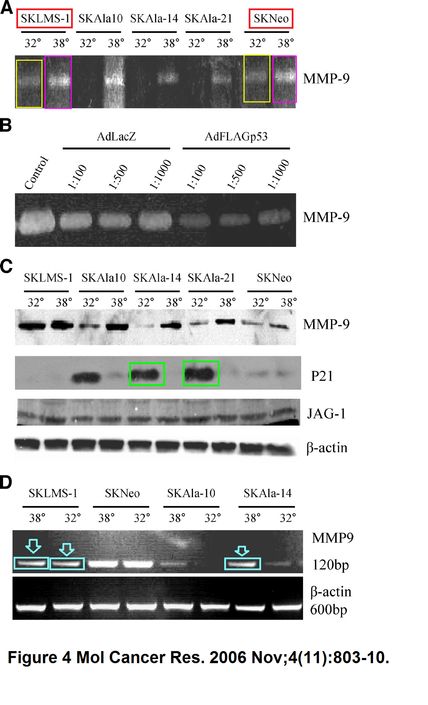
Her husband, Raphael E. Pollock (now Ohio State) recently went to PubPeer commenting on their joint papers and refuting all evidence of data irregularities, unconvincingly.
https://pubpeer.com/search?q=dina+lev
E.g:
Pollock wrote: “No comment from complainant; careful scrutiny of figures reveals subtle but definite differences in the bands that the complainant has highlighted.”
One paper with Lev as last author was retracted by PLOS One, Pollock is not on it. The authors opposed the retraction.
https://pubpeer.com/publications/B0C3E8A174168169E76500DD0F49B3
https://journals.plos.org/plosone/article?id=10.1371/journal.pone.0214006
Complicated story.
LikeLike
More yeast problems from Spain, group of José R. Perez-Castineira and Aurelio Serrano in Sevilla. In particular Drake_et_al_2010 is very interesting (first link), with a lively conversation with Dr. J.R.P.-C.
https://pubpeer.com/publications/2BB837A89FA48EAAADD950AA820B04
https://pubpeer.com/publications/E508D13C9E57C1592418405681BD9D
https://pubpeer.com/publications/DF63F425206425A593483DF132DACB
Same group, with Western blot issues only:
https://pubpeer.com/publications/0E583295879BE9153B824EE6BD79B9#1
https://pubpeer.com/publications/A8788D1B1318A7DE85D9C25B25D53C
LikeLike
Maybe an evil pin replicator again? LOL
LikeLike
More fake data by one of the “heroes” mentioned in this article, Vicente Rubio (CNB Madrid):
https://pubpeer.com/publications/AADA590CEF96FEF6847BEC0CAB44FE
(PubPeer post by Elisabeth Bik, who was alerted by a reader).
LikeLike
Yeast & Spain, an indissoluble union in plant sciences:
https://pubpeer.com/publications/91F9823EFD1B84F592C9FD379D32EB
https://pubpeer.com/publications/32630E1DA90354899F8E0C4F8745B7
LikeLike
Pingback: Iberian yeast masters do it classic with a flip – For Better Science